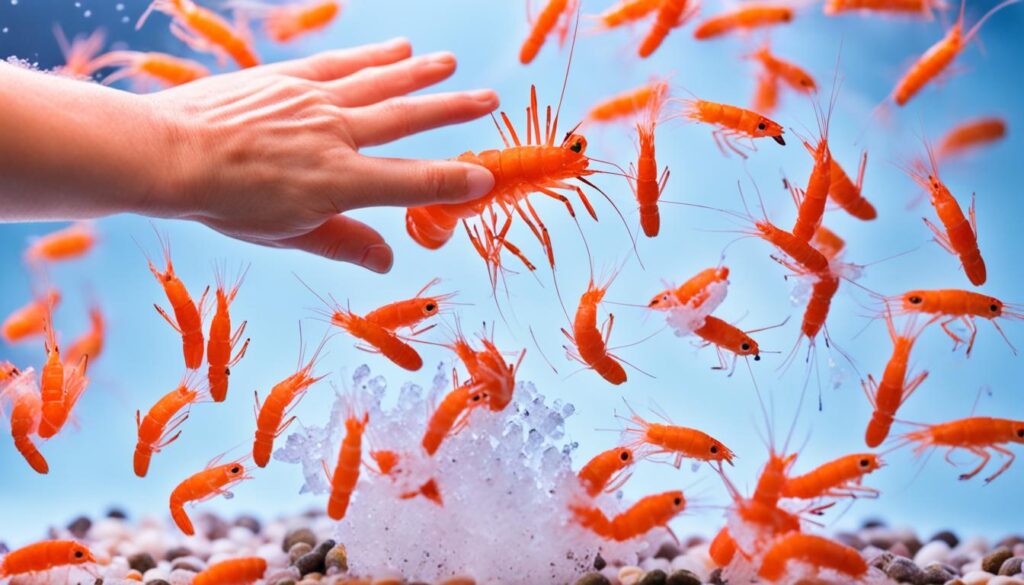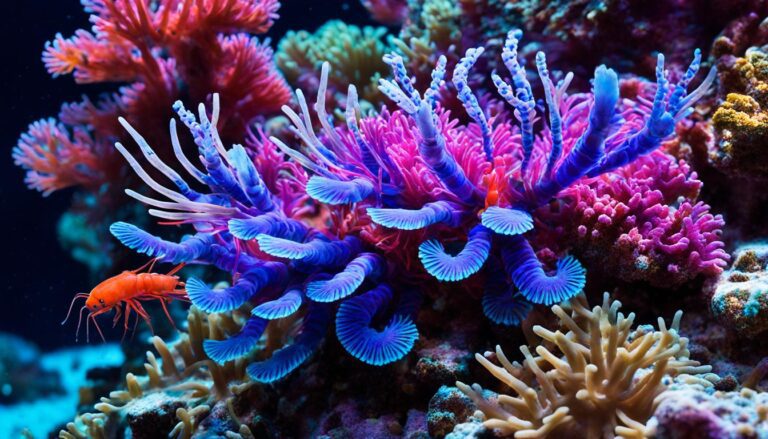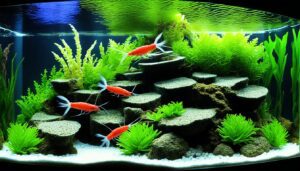Peppermint shrimp might look small but they’re huge for your reef tank’s health. They can live for years and grow up to 2 inches big. Peppermint shrimp care is both an art and a science. The right water conditions and tank mates make a big difference.
These shrimp are known as Lysmata wurdemanni and are a bright part of the reef. They look like peppermint candies with their red and white stripes. They’re great at feeding peppermint shrimp and help control pests like aiptasia anemones.
For peppermint shrimp tank requirements, stability is key. They need a 10-gallon tank with a temperature of 72-78°F and a pH of 8.1 to 8.4. Aquarists love them for their hardiness and how they help keep the tank clean.
Peppermint shrimp show how important balance is in the ocean. They need the right care and tank mates to thrive.
Let’s dive into what it takes to care for these red-striped reef guardians in your marine tank.
Peppermint Shrimp Species Profile

Let’s dive into the world of peppermint shrimp, focusing on Lysmata wurdemanni. We’ll explore their habitat, breeding, and what you need for them in a saltwater tank. This is key for anyone wanting to keep these colorful crustaceans in their aquariums.
The Origins of Lysmata wurdemanni
The Lysmata species, like L. boggessi and L. wurdemanni, often spark debates about their classification. But their roles in the ocean are clear. L. wurdemanni stands out with its bright red and white stripes and its pest control on aiptasia. They’re great at peppermint shrimp breeding, with up to eight young shrimps per batch.
They’re protandric simultaneous hermaphrodites, meaning two can breed and switch sex if needed. This unique trait makes their breeding process fascinating.
The Habitat of Peppermint Shrimp
Peppermint shrimps love environments that mirror their natural rocky reef homes. They need lots of live rock and places to hide. So, your tank should be at least 10 gallons to give them room to move and hide.
Water quality is key, with a temperature of 75°F to 82°F, pH 8.1 to 8.4, and specific gravity 1.023 to 1.025. This keeps them healthy and happy.
It’s also important to know how well peppermint shrimps get along with other sea creatures. They’re usually peaceful but can be territorial with smaller or similar species. Make sure they get along and the tank is set up right for them. They can be a great and helpful addition to your reef tank.
Suitable Tank Setup

Creating the perfect environment for peppermint shrimp means knowing their needs. We’ll cover the key water conditions and the best tank mates for them. This ensures a peaceful and thriving home for your shrimp.
Water Requirements
Peppermint shrimp need a stable home. They do best in water that’s 72-78 degrees Fahrenheit. The pH level should be 8.2-8.4, and the specific gravity 1.023-1.025.
This matches their natural habitat, helping them grow and stay active. Using timers for lighting helps keep the environment stable. It’s vital for the shrimp’s health. Regular checks and upkeep are key to keeping your shrimp happy and healthy.
Compatible Tank Mates
Peppermint shrimp get along with many reef creatures. They should be kept in small groups of 4-5 to prevent stress. Make sure your tank is big enough to stop fights over space.
Great tank mates include:
- Yellow Tangs: These fish are colorful and peaceful, fitting well with peppermint shrimp.
- Coral Beauty Dwarf Angelfish: They’re colorful and peaceful, loving the reef life with peppermint shrimp.
- Pajama Cardinalfish: These fish are calm and swim slowly, making them perfect tank mates.
- Mandarin Gobies: They’re known for their unique look and calm nature, fitting well with peppermint shrimp.
Choosing the right tank mates makes your tank look good and keeps all the creatures happy and stress-free.
Nutrition & Diet

Feeding peppermint shrimp the right way means knowing what they like to eat and need. These shrimp eat a bit of everything in a reef tank. Here’s a guide on feeding them well.
Peppermint shrimp love to eat detritus and Aiptasia, which helps keep the tank clean. But, they also need extra food to stay healthy and colorful. I feed them small pieces of fresh fish, shrimp pellets, and sometimes brine shrimp eggs. It’s important to feed them a little bit often to keep the water clean.
- Regular monitoring of tank iodine levels is also vital, as it supports healthy molting and vibrant coloration.
- Creating an environment that mimics their natural habitat reduces stress, making them more active and healthier.
- Observation of their nocturnal activities provides insights into the dynamics of your reef ecosystem, enhancing your feed strategy accordingly.
Here’s a detailed breakdown of the feeding regime for peppermint shrimp that you might find helpful:
Food Type |
Frequency |
Benefits |
|---|---|---|
Marine Pellets |
2-3 times a week |
Complete nutrition |
Fresh Fish Pieces |
Once a week |
Richest protein source |
Brine Shrimp Eggs |
Occasionally |
Enhances coloration |
Detritus & Aiptasia |
Constant (as available) |
Natural food source, controls Aiptasia population |
Peppermint shrimp do well with a balanced diet and stable water. Keeping the water’s salinity, temperature, and pH right helps them. A healthy shrimp makes your marine aquarium better!
Breeding

Peppermint shrimp breeding is a unique challenge due to their special way of reproducing. These creatures, known as Lysmata wurdemanni, can be both male and female at the same time. They start as males, then change to females after shedding their skin. This ability makes them interesting to breed but requires careful conditions for success.
To breed peppermint shrimp, you need a special setup. This includes drilling holes in a bucket and adding a thick filter mat with fine sand on top. This setup helps the eggs hatch into larvae, which takes about 10-12 days. Breeders can expect around 100 larvae per spawn, but half might not make it past the first two weeks due to water quality and feeding issues.
Molting
Molting is a key part of the peppermint shrimp life cycle. It’s when they shed their skin for growth. During this time, they hide in the tank until their new shell hardens. Molting shows they’re ready to breed and can lay eggs after shedding.
To help peppermint shrimp molt and breed well, you need to keep their tank just right. The water should be between 79.5 and 82.5 degrees Fahrenheit, with a specific gravity of 1.025 and pH levels from 7.95 to 8.22. Keeping these conditions right is crucial for their health and survival.
Breeding peppermint shrimp is both fascinating and challenging. With careful attention and patience, aquarists can successfully raise these colorful shrimps. This adds a vibrant touch to marine aquariums.
Where to Buy Peppermint Shrimps?

When looking for where to buy peppermint shrimp, it’s key to choose trusted sources. This supports the health of aquatic life and makes sure the shrimp are fit for your aquarium. It also helps keep the ocean’s balance.
Here’s a checklist to help you find the best place for healthy, reef-safe peppermint shrimps:
- Find sellers who focus on captive-bred peppermint shrimp. This ensures they’re ready for aquarium life and fight off diseases better.
- Make sure the shrimp are active and show their bright colors. This means they’re healthy.
- Read what customers say about the shrimp’s health when they arrived and how many survived. It shows how well the seller ships and cares for the shrimp.
- Make sure the seller keeps the water right for peppermint shrimp. They need a temperature of 72-78°F, pH of 8.2-8.4, and specific gravity of 1.023-1.025.
It’s smart to ask if the supplier is ethical. Look for ones that replace or give store credit if shrimp don’t make it. AlgaeBarn is a trusted brand that offers a Alive on Arrival (AoA) guarantee for their peppermint shrimp.
Remember, getting peppermint shrimp right is all about proper acclimation. If you don’t do it right, many shrimps won’t survive in your tank. This has happened to many people who didn’t acclimate correctly.
Is Peppermint Shrimp a Good Choice for Your Tank?
As an aquarist, keeping your reef tank healthy and balanced is key. Peppermint shrimp care is often talked about because they help fight aiptasia and clean the tank. Many people, like the 43,000 who read a detailed guide, see their value as cleaners and fun additions.
Before deciding on peppermint shrimp for your tank, think about their behavior and how they fit with other tank mates. It’s important to know what they need to stay healthy.
Looking into peppermint shrimp tank requirements, you’ll see they need stable conditions. With the right care, like drip acclimation, they can be great helpers. But, it’s important to tell them apart from similar shrimp, like camel shrimp, which eat coral.
Knowing about peppermint shrimp compatibility is crucial. They fight aiptasia well but might harm some corals. So, pick your corals carefully.
On the other hand, cleaner shrimp or fire shrimp are more visible and active. But peppermint shrimp are cheaper and have their own benefits. They eat bristleworms, which can be a problem in reef tanks. Shrimp aren’t the main cleaners, but peppermint shrimp can help with parasites. They make good tank mates if you watch them closely.








